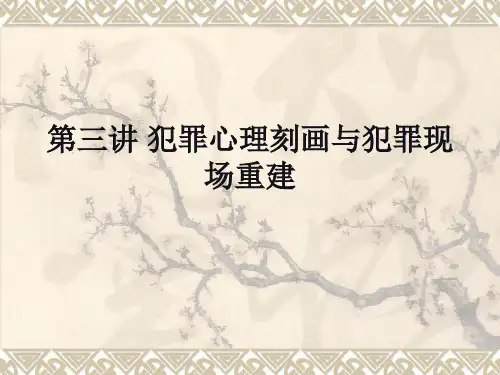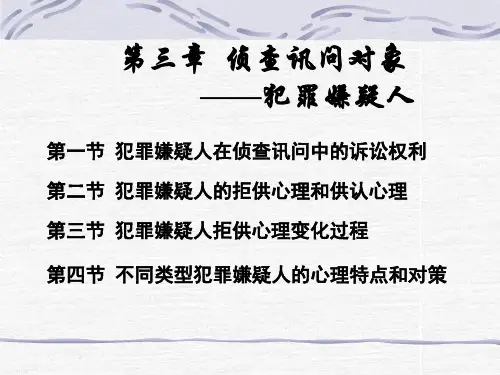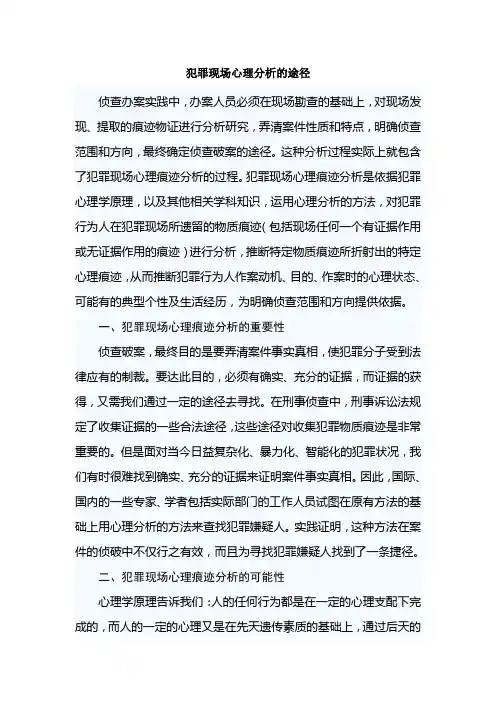侦查心理学-第三章 现场心理
- 格式:ppt
- 大小:1.11 MB
- 文档页数:31




浅谈犯罪现场心理痕迹【摘要】:作案人在作案过程中除了留下各种各样的物质痕迹以外,还会留下潜在的心理痕迹,通过现场勘查,提取遗留在现场中的各种痕迹物证,来分析作案人实施犯罪的心理过程,对于推断作案人的犯罪行为动机和目的,认定案件性质,明确侦查方向和范围,具有重要的指导意义。
【关键词】:物质痕迹;心理痕迹;现场勘查作案人在作案过程中除了留下各种各样的物质痕迹以外,还会留下潜在的心理痕迹,通过现场勘查,提取遗留在现场中的各种痕迹物证,来分析作案人实施犯罪的心理过程,对于推断作案人的犯罪行为动机和目的,认定案件性质,明确侦查方向和范围,具有重要的指导意义。
一、犯罪心理痕迹概述近年来,犯罪心理痕迹研究受到我国侦查学界的关注,不同学者给予了不同的定义,作者查阅了资料,主要观点如下:1. 犯罪心理痕迹,专指犯罪人大脑对经历过的特殊事件(犯罪)的认知及记忆【1】2.犯罪心理痕迹是指犯罪人在实施犯罪行为过程中表现出来的,通过犯罪行为间接地反映在犯罪现场遗留痕迹之中的某些比较稳定的、典型的心理特点”【2】3.犯罪现场心理痕迹是犯罪现场客观事物形象的心理属性,或者说现场心理痕迹是犯罪人的心理要素通过犯罪行为赋予犯罪现场客观事物形象的属性【3】4.(犯罪)心理痕迹是指犯罪分子在实施犯罪的过程中,在犯罪现场上能够直接或间接地反映出犯罪心理活动的一切现象,它可以反映出犯罪分子的心理活动过程,心理状态和个性心理特点【4】5.现场心理痕迹是指犯罪分子在实施犯罪过程中和犯罪前后的心理活动,通过行为结果间接地反映在犯罪现场物质痕迹或被害人、事主和知情群众记忆之中的某些带有犯罪意向性、一致性、典型的心理特点【5】6.犯罪心理痕迹是相对于犯罪现场中的物质痕迹而言的”它是犯罪人个性心理在犯罪行为发生过程中客观反映【6】7.现场心理痕迹是指犯罪行为发生的过程中所表现出来的,通过犯罪行为储存在一定载体上的犯罪嫌疑人的心理过程!心理特征和心理状态(心理活动)”【7】通过对上述不同概念的分析比较,可以看出,这些不同的定义之间有异同之处。


侦查心理学第一章侦查心理学概论第二节侦查心理学的方法读心术一、心理判断分析1.人的心理是可以判断分析的,人不是不可貌相,关键是谁来相。
2.人的心理是难以判断分析完全的,只能尽可能完全、准确。
3.心理判断分析的应用广泛,几乎无所不在。
4.分析判断的方法、途径多多,本课仅重点介绍。
心理判断分析(一)作用:从古到今广泛用于政治、军事、商业、企业管理以及个人生活,人际关系处理、建立威信等(二)任务:长、短判长:需求、个性特征、弱点、经历、职业特征等。
判短:目前心态、心思及情绪。
在侦查实践中:街头识别人、抓扒手;与劫持犯谈判;调查讯问中应用等。
心理判断分析(三)定义指针对某人或某事,运用心理学知识,按照辩证的观点,分析某人或某事所反映出的行为模式特点和心理活动特点。
心理判断分析二、心理分析基本途径常用的途径分析途径1、外部表现(察言观色)机理(心理活动规律):内心活动总要外化为表情、动作、姿势。
在一定范围内,内心活动将影响外部表现。
故可通过外部表现认识人的某些内心心理活动,尤其思、情、意为主的内心感受和活动规律。
①眼神―“目听”孟子曰:“存乎人者,莫良于眸子。
眸子不能掩其恶。
胸中正,则眸子瞭焉;胸中不正,则眸子眊焉。
听其言也,观其眸子,人焉廋哉?”《孟子·离娄上》第十五章②面部表情―“色听”更多地反映个性。
先天性的面部表情肌联动模式。
微表情:大脑作出思考前,面部表情的瞬时快速反应(一般表情2-3秒,微表情仅4毫秒,且幅员不大如额头沟纹、皱眉、眨眼、抿嘴)。
微表情与主要面部表情,言语表达内容相矛盾,提示不自在、紧张心态-可能谎言。
热点:说话者的部分面部表情与言语表达内容不一致,与特定环境不协调。
机理与测谎仪、“马上风”同。
③姿势、动作:身势语言反映情绪及思想,也可帮助认识对象的内心活动,掌握其心理特点。
心理学研究成果:身势肢体语言表达信息大于言语的表达。
(约65%-35%)变化:更反映内心心态A.眼神变化:眼神游移不定、左顾右盼------贼眉鼠眼则有说谎可能;对象回答问题时―眼光迎向讯问者―心态情绪稳定;对象回答问题时―目光移开或低头闪躲―心中有鬼。


Criminal Investigative Psychology(侦查心理学)双语教学大纲编制说明《侦查心理学》为专业基础课,适用于侦查系本科学生。
本课程的教学目的是使学生了解国外侦查心理学的前沿理论与相关研究,同时掌握侦查过程中的各种心理现象,能够运用心理学的基本原理去解释侦查过程中的各种主体的行为以及解决侦查中的问题。
主要内容包括犯罪人特征剖析(Criminal profiling),讯问中的心理分析与对策(Interviewing suspects),询问证人的方法(Cognitive interview)等。
本课程以启发学生重视心理学在侦查活动中的运用为主要原则,通过对原文的研读和讲授,提高学生直接阅读外文文献的能力。
教学以讲授法兼课堂讨论、案例分析为主要方法,培养学生自主学习的能力,以及运用理论分析问题、解决问题与实践应用的能力,注重理论联系实际,突出公安特色。
《Investigative Psychology》双语教学大纲是本课程开展教学活动的基本依据。
由赵桂芬执笔,经征求相关专家意见,并由侦查系毕惜茜审阅后,于2009年1月14日由侦查系学术委员会审定。
一、课程名称:Investigative Psychology(侦查心理学)二、课程性质:专业基础课三、授课对象:侦查专业本科学生四、总学时数:28学时,其中讲授21学时五、教学内容:Investigative Psychology: Introduction教学目的和要求:Through teaching, students should have a clear concept about Investigative Psychology; learn about the development of IP as well as the research area of IP. Student should keep in mind about what psychology can contribute to criminal investigation.重点与难点:The stressing point is the definition of Investigative Psychology as well as research area of IP. The difficult point is the definition.学时数:2学时主要内容:1.Definition of Investigative PsychologyDefinition from David Canter. “Investigative Psychology covers all aspects of psychology that are relevant to the conduct of criminal or civil investigations.”Broad and Narrow perspective:Broad one is a term encompassing all the ways that psychology can be used or integrated with the processes and procedures of criminal investigation. Narrow one is a term referring to methods of identifying key features of a crime and the likely characteristics of the perpetrator.The relationship with Forensic Psychology: Investigative Psychology is the subfieldof Forensic Psychology.Ours perspective: Narrow definition: a subject that focuses on the psychological phenomenon and it‟s regularity w hich are related to investigators in the proceeding of investigation. Broad definition: a subject that focuses on the psychological phenomenon and it‟s countermeasures regarding with all individuals who might be involved in the proceeding of criminal investigation2.The development of IPIntroducing the lasted research method and research outcome of the Center of Investigative Psychology in Liverpool University.3.Research area of IPPolice psychology; Criminal profiling; Interrogation; Interviewing; Negotiation in hostage taking; Psychological autopsy.4. SummaryChapter 1: Early approaches to profiling教学目的与要求:Help students recognize the evolution of the approach of criminal profiling. Students should know about the assumption and functions of profiling. 重点与难点:Focus on the assumption and functions of profiling. The assumption about profiling is the difficult point.学时数:4学时主要内容:Overview1.The definition of profiling1.1A process by which “offender characteristics can be deduced from a detailedknowledge of offence characteristics”.1.2When is Offender Profiling used?In general applied for serial cases, typically for serious crimes when the suspect is unknown. Nowadays, it has also been successfully used with less serious crime e.g.arson and burglary2. The function of profiling2.1Deducing the characteristics of an unknown offender2.2Understanding an offender‟s behaviour and/or future level of threat to others2.3Giving advice to officers on how to interview a suspect2.4Determining whether offences are linked through analysis of their behavioural characteristics.2.5Geographical profiling, which can be used to narrow down the search area of offender.3. The history of profilingThree stages of the development of profiling: Observation; Classification; Knowledge about Criminals and their Actions.4. The assumptions of ProfilingThe rational relies on the uniqueness of experience & different personality types will be reflected in lifestyles & behaviour. This leads to assumptions about profiling:4.1 Coherent relationship between crime scene and offender‟s personality: the crime scene reflects the personality4.2 Personality will not change. We can infer the behavioral pattern of offenders in their daily lives.FBI’s Profiling Approaches1.The early research method of the FBI‟s profiling system.The early work was carried out at the FBI…s Academy in Quantico, Virginia in 1970‟s.From it‟s ownofficers‟ experience in the investigation of serious sexual assault and murder, They also carried out extensive interview with some 36 convicted serial murderers.2. Profiling approach2.1 Information needed for profilingInclude a careful examination of the attacks themselves, a study of the nature of the attacks themselves, consideration of any forensic evidence, c areful consideration of the medical examiner‟s report, the identification of the characteristics of the type of victim selected.2.2. Profiling sequenceSix Steps: Profiling Inputs; Decision Process Models; Crime Assessment; Criminal Profile; Investigation; Apprehension3. Serial Killers- Typologies3.1Early classification3.2Other classifications: selfish vs. unselfish rapists.3.3Further classification of rapists: Power reassurance type vs. power-assertive type;Anger-retaliatory type vs. Anger-excitement type.4.The functions of categorization might have4.Functions of categorization might haveA very careful examination of the offence and the circumstances surrounding it would reveal a great deal about the type of offender who committed a crime. Meanwhile, the information obtained from interviews with these types of offenders is of considerable value to investigating officers.5.SummaryChapter 2: Investigative psychology and the work of David Canter教学目的与要求:Student should know that Canter‟s research is based on psychological principles and knowledge; understand Canter‟s approach of profiling andnarrative theory. Further, Students should know about the operative aspects of geographical profiling, and can do criticism about David Canter‟s approach.重点与难点:Focus on profiling approach, i.e., five-step model as well as geographical profiling. The difficult part is the understanding of the psychological underpinning.学时数:6学时主要内容:Overview of Five-step Model1.The psychological underpinning of Canter‟s work2. Narrative TheoryNarrative theory is based on the way in which we live our lives according to …scripts‟ which help us to make sense of the world. Our inner-narratives dictate the way in which we deal with people and situations, in both criminal and non-criminal interactions.3. Canter‟s approach of profiling-Five steps model3.1 Interpersonal coherence.Refers to the way in which people adopt a style of behaviour when dealing with others.3.2 Criminal characteristics. Distinguishes between different types of crime.Allows researchers and investigators to establish the …type‟ of offender they are looking at.3.3 Criminal career. Criminals will operate in a consistent way, but will also learn and adapt3.4. Forensic awareness. Means prevention or removal of evidence, such as DNA or fingerprints.3.5 Time and place. Draws on environmental psychology.Canter’s Work on Crime Loc ation1.Canter‟s work on crime location: Geographical ProfilingGeographical profiling is based on environmental psychology principles. The rationale is that majority of offenders operate in limited space and in areas in which they are familiar. The objective is to predict offender‟s home base from crime scene locations.2.The understanding of Mental MapMental maps are internal representations of the external world, and are unique to each individual.The reason why the study of mental maps might be important is that each criminal will have their own mental map of the area in which they live and operate.3.Circle hypothesisCircle theory does apply to most cases of serial rape and homicide but not to all such cases and also not necessarily to other types of crime.4.Rossmo‟ work on geographical profilingRossmo has done some research on the relationship between crime types and travelling distance, and come up with his theory. His techniques are particularly appropriate to serial offending, esp. that involving violent and sexual crimes.5.Concluding commentsProfiling is not a diagnosis or penal classification: profiling typically cannot identify an individual but can give insight into the general personality and characteristics of the person responsibleCase analysis about serials killer in China1.Introducing a serial killer named Hongjun Yang in Jilin province as well asZhihong Zhao in Leimeng Province.2.Describing their behavioral patterns while committing killing.3.Analyzing their characteristics from the perspective of psychology, socialpsychology and psychoanalytic theory as well as other theories can be applied.Chapter 3: Interviewing Suspects教学目的与要求:Students should know about the role of psychology in the proceeding of interviewing suspects; understand the principle of investigative interviewing in UK; learn the attribution of suspects and the effects.重点与难点:Focusing on the deception detecting and false confession, as well as the attribution of suspects, which is also the difficult part.学时数:4学时主要内容:1.The role of psychology. Suspect interviewing is an area in which the application of findings from psychological research may be appropriate.2. Investigative interviewing. Focus on the principle of investigative interviewing3. Attribution of suspectsIf one takes the typical scenario of an interview with a suspect it may be possible to see what attributions might be made.3.1Common attribution of suspects: the police have a reasonable suspicion that theperson has committed an offence; The suspect was found near the scene of a crime or because he or she matches the description given by a witness; The suspect has previous convictions for the same type of crime, then the police may already havecome to believe that the individual is more than likely responsible.3.2In such attribution, the police may approach the interview itself with such belief:that the person has committed the offence in question and that the purpose of the interview is simply to persuade him/ her to admit involvement in the crime.4. Identifying those who are lying4.1 Oxford claims that 'suspects usually lie in order to avoid guilt or criminal proceedings'.4.2 Vrij suggests that there may be some advantage in training police officers to look for such indirect measures of deception rather than have them rely on their stereotypical (but often incorrect) assumptions about the behaviour of liars.5. False confession5.1 The cause of false confession.5.2 A confession has a compelling influence on jurors and they are more likely to convict on the basis of a confession than anything else.6. Types of confessionGenerally, the classification is based on the motive of confession, include following types: to achieve fame or notoriety, to assuage guilt feelings, to protect another individual, from an individual confusing fantasy with reality, etc.5 .who is most likely to confessionGudjonsson has attempted to identify the sort of person who is most likely to be coerced into making a confession. He has developed a scale of interrogative suggestibility which he claims can separate out those more likely to confess from those who are less likely to do so.Chapter 4: British and American Interrogation Strategies教学目的与要求:Help students understand the characteristics of interrogation and confession, thus, they would know why false confession are easy to be happened. Students should know interrogation principles that applied in UK and it‟s rationale, also, they should examine the basic pattern of interrogation and its rationale. Interrogation training can be learnt as a common sense.重点与难点:Focus on the characteristics of interrogation and confession as well as the feasibility of new interrogation principle in UK, the nine steps of Reid‟s techniques. The difficult part is the nine-step techniques.学时数:6学时主要内容:1. Understanding of interrogation and confession1.1 The characteristics of Interrogation and confessionThe characteristics of Interrogation and confession are as follows: A critical stage in criminal investigation; A closed social interaction; A confession is likely to be unreliable by its nature.1.2 How to understand “a closed social interaction”2. Interrogation principles have been change in UK2.1Two kinds of changes: Defensive lawyers have presented; using an audio or video tape to record the course of interrogation.2.2 The principle of the acceptance of confession has been changedFrom voluntary to reliability3. The change is slowThe t ransition from coercive questioning practices to a new ethos of “searching for the truth” has been difficult for some police. The cause is that “Openness” may be odds with the very adversarial nature of the criminal law and the police culture.4. Police interrogation in AmericaPolice interrogation in the United State in stark contrast to the legal system in England, deception is considered by the American police, also, the courts play a natural part of detecting. The law in US always supports police deception.5. Interrogation training5.1 US police are permitted by the courts to engage in trickery and deception and are trained to do so by the police organization.5.2The training is generally carried out by outside commercial training organizations.6. Police Interview Techniques: (Inbau, Reid, Buckley & Jayne (2001). USA.)Reid Technique6.1 The goal of interrogation, is to breaks down denials and resistance, to Increases the suspect‟s desire to confess.6.2 Categorisation. Two types of suspect: Emotional: remorse –sympathetic approach; Unemotional: no remorse –factual analytic approach that appeals to common sense & reasoning.6.3Nine stepsPre-interviewD irect positive confrontation: interviewer presents his …absolute certainty‟ of guilt.Theme developmentHandling denials. Repeated denials give suspect advantage. Interruption advocated.Overcoming objections. In guilty suspects denials tend to become objections.Procurement and retention of suspect‟s attention. E.g. move close, make eye contact.Handling susp ect‟s passive mood. This is a psychological state that precedes confessionPresenting an alternative question. Give a highly incriminating account followed by a face-saving one.Suspect orally relates details of offence (post confession).Converting oral confession into written one. This should be done quickly to preventretraction.6.4 Problems with Reid methodThe problem is that the validity of this method is not backed up by empirical support. The technique mainly relies on the assumption that the police are good at detecting deception.Chapter 5: Cognitive interview教学目的与要求:Students should know the concept of cognitive interview, mastery of the techniques of cognitive interview.重点与难点:Focus on the techniques of both cognitive techniques and its enhanced version. The difficult is the theory that supports this interviewing approach.学时数:4学时主要内容:1. Discuss importance of the Cognitive Interview1.1The elicitation of complete and accurate witness accounts may determine whether or not a case is solved1.2The need to identify and develop techniques that police investigators can themselves use in questioning witnesses1.3To use memory theory and research for the development of the techniques2. Cognitive Interview Techniques2.1Context reinstatement2.2Report everything2.3Change order2.4Change perspective3. The Enhanced Cognitive Interview3.1Greet and establish rapport3.2Explain the aims of the interview3.3Context reinstatement3.4 Initiate free report3.5Witness compatible questioning3.6Recall in a different order3.7Change perspectives3.8ClosureChapter 6: Person perception and interpersonal skills教学目的与要求:Recognize the three factors influencing perception. Through self assessment, gain insight on how one‟s own perception impacts understanding of people and situations重点与难点:Focus on the factors impression formation and related factors. The confusion part is how to form objective impression about suspects.学时数:2学时主要内容:1.Perception1.1Factors Influencing Perception1.2 Impression formationWhenever an individual meets someone for the first time they tend to form an immediate impression of that person. We often form impressions rather quickly, sometimes without any direct evidence.Key factors: Facial appearance; Hairstyle and clothing; Physique; Voice and speech style.2. Non-verbal communication (NVC)2.1The importance of NVC in an officer‟s decision-making.When questioned, the suspect may well deny any wrongdoing but the officer may be justified in examining other signals that being given off whilst the denial is being made.The officer may use age and race as early filtering devices when deciding who to stop on the street, NVC may also alert the officer that the person appears to have something to hide.2.2Some significant clues: Gestures; Posture; Eye contact and other speech regulators; Gestures 4.SummaryChapter 7: Attribution, prejudice and stereotyping教学目的与要求:Student should know the fundamental attribution theory and the attribution errors; recognize factors that are used to the advantage or detriment of understanding others.重点与难点:Focus on attribution theory and it‟s connection with policing. the confused part is the prejudice and stereotyping.学时数:2学时主要内容:1.Attribution Theory1.1internal vs. external attributionA person tries to determine whether another person‟s behavior is caused by internal or ex ternal factors. This is conditioned by three attributes: consensus in behavior; consistency in behavior; distinctiveness in behavior.1.2 Other attributions1.3 Attribution Theory Errors2 Prejudice and stereotyping2.1Prejudice and policing2.2 Stereotyping: Judging someone on the basis of one‟s perception of the group to which that person belongs.3. Ethnocentrism and social identity theory4. SummaryWe need to study perceptions in a systematic manner to improve our decision-making performance.教学安排表:考核方法:主要采用试卷考核的方式,也可以根据教学需要采用口试、论文、调查报告等形式,平时成绩应占一定比例。

犯罪现场心理分析的途径侦查办案实践中,办案人员必须在现场勘查的基础上,对现场发现、提取的痕迹物证进行分析研究,弄清案件性质和特点,明确侦查范围和方向,最终确定侦查破案的途径。
这种分析过程实际上就包含了犯罪现场心理痕迹分析的过程。
犯罪现场心理痕迹分析是依据犯罪心理学原理,以及其他相关学科知识,运用心理分析的方法,对犯罪行为人在犯罪现场所遗留的物质痕迹(包括现场任何一个有证据作用或无证据作用的痕迹)进行分析,推断特定物质痕迹所折射出的特定心理痕迹,从而推断犯罪行为人作案动机、目的、作案时的心理状态、可能有的典型个性及生活经历,为明确侦查范围和方向提供依据。
一、犯罪现场心理痕迹分析的重要性侦查破案,最终目的是要弄清案件事实真相,使犯罪分子受到法律应有的制裁。
要达此目的,必须有确实、充分的证据,而证据的获得,又需我们通过一定的途径去寻找。
在刑事侦查中,刑事诉讼法规定了收集证据的一些合法途径,这些途径对收集犯罪物质痕迹是非常重要的。
但是面对当今日益复杂化、暴力化、智能化的犯罪状况,我们有时很难找到确实、充分的证据来证明案件事实真相。
因此,国际、国内的一些专家、学者包括实际部门的工作人员试图在原有方法的基础上用心理分析的方法来查找犯罪嫌疑人。
实践证明,这种方法在案件的侦破中不仅行之有效,而且为寻找犯罪嫌疑人找到了一条捷径。
二、犯罪现场心理痕迹分析的可能性心理学原理告诉我们:人的任何行为都是在一定的心理支配下完成的,而人的一定的心理又是在先天遗传素质的基础上,通过后天的环境教育影响形成的,因此人的一定的行为能反映出人的特定的心理状态、个性乃至整个人的面貌。
犯罪行为是犯罪主体对犯罪客体的作用,因此总要形成一定的物质痕迹,而犯罪行为人在现场留下的物质痕迹,是其犯罪行为、犯罪心理及其他心理的外化表现。
所以,犯罪现场痕迹中一定隐含着相应的心理痕迹。
它是犯罪行为人心理活动和外部行为综合作用的结果,这是事物发展联系内在逻辑的充分体现,也是现实的一种客观存在。

侦查人员在侦查过程中的心理侦查人员在侦查过程中的心理侦查活动是司法实践活动的重要环节,其主要任务是揭露和证实犯罪。
在侦查活动过程中,侦查人员根据侦查工作的需要,自觉进行自我心理调控,并针对犯罪嫌疑人及其他与犯罪有关人的心理活动规律和特点,实施相应的侦查心理对策,有助于提高侦查实践活动的效率。
侦查活动是在侦查人员的一系列心理的支配和调节下进行的。
侦查人员对于自己在侦查活动过程中的心理活动首先要有自觉的认识,才能进行有效的自我心理调控,从而保证侦查活动的顺利进行。
一、侦查人员在侦查过程中的认识犯罪嫌疑人及其犯罪活动虽然是客观存在的事实,但是在案件未侦破以前,却是隐蔽的。
必须通过刑事侦查人员的认识过程,才能揭露和证实隐蔽的犯罪嫌疑人和犯罪事实。
因此,侦查人员在侦查过程中的认识活动极为重要。
人的认识是通过感知、记忆、想象、思维各种心理过程,对客观事物由表面现象到本质和规律的主观能动的反映过程。
侦查破案过程也是一种认识过程,这种认识过程有其自身的特点。
认识时间的紧迫性。
侦破工作是一项时间性十分紧迫的工作,必须抓住犯罪现场尚未被破坏、犯罪痕迹清晰、脏物尚未脱手、罪证尚未销毁、犯罪嫌疑人尚未远逃、被害人和证人的记忆清楚等有利时机,侦破工作才能做到事半功倍。
否则,如果贻误破案良机,则会事倍功半,给侦破工作带来极大的困难。
认识的间接性。
侦查工作是由已知的犯罪结果,追溯过程,查找、确定犯罪嫌疑人的间接认识过程。
认识对象的隐蔽性。
犯罪嫌疑人为了逃避侦查,在作案前、作案中和作案后,一般都作了充分的反侦查的心理准备,实施各种反侦查的措施。
如制造各种假象,编造各种谎言,与同伙订立攻守同盟;破坏现场,消灭作案痕迹,毁灭罪证;或贼喊捉贼转移侦查人员的视线等。
这就给侦查工作带来极大的困难,往往使侦查人员对案件的认识陷入某些误区。
因此,侦查人员在侦查活动中,自觉进行心理的自我调控,避免认识的误区是非常重要的。
(一)侦查人员在侦查过程中的注意侦查活动是由许多环节组成的十分紧迫而细心的工作,在某一个环节上出现认识的疏忽或错误,都会使侦查工作走上弯路而贻误侦查的有利时机,造成工作的困难或失败。

论现场心理痕迹的运用内容摘要理论上犯罪现场有两种痕迹,物质痕迹和心理痕迹。
其中,心理痕迹能客观的反映犯罪人的客观心理意识和活动。
探明犯罪人的心理意识,一方面有利于案件的侦破,另一方面心理意识也是法律定罪量刑的一个必不可少的标准。
因此,对现场心理痕迹的观察研究是侦察过程中必要的步骤。
关键词犯罪现场心理痕迹侦查运用正文任何的犯罪行为都会留下痕迹,有有形的物质痕迹和无形的心理痕迹。
心理痕迹是指犯罪人在实施犯罪行为的过程中表现出来的某些稳定的、典型的心理特征。
无形的心理特点通过犯罪行为间接地反映在犯罪现场的有形痕迹之中, 客观地反映了犯罪人的心理意识和心理活动。
心理痕迹是寓于物质痕迹的,但它的作用不同于简单的物证。
物证是指向犯罪人和犯罪行为的联系,心理痕迹则是串联起物证的导线,导线接通,物证的存在才有意义。
没有心理痕迹的研究,物证也只是零碎的单个物件而已。
所以在侦查案件过程中对心理痕迹的有意识的收集是必要的。
一、犯罪心理痕迹的概念佐罗在“劫富济贫”之后总会留下“Z”字剑痕以表达“此事是我所为”的英雄主义;初次入室盗窃的盗窃犯开锁的痕迹会比较混乱和模糊,因为初次犯案,内心的激动和紧张;纵火惯犯通常为男性并且对火焰有较大的喜好。
事物总是共性和个性的存在,犯罪人也一样。
同一类型的犯罪人,总会有相似的心理意识,也就会在相似意识的主导下做出相似的行为,从而留下相似的心理痕迹。
所谓犯罪心理痕迹就是指,犯罪人在实施犯罪行为的过程中表现出来的某些稳定的、典型的心理特征。
犯罪心理痕迹的研究基于心理学理论,心理学上认为,人的性格具有稳定性。
犯罪心理也是心理学的一个部分,所以同样也具有一定的稳定性。
例如强奸杀人犯还将死者的衣服穿好,表现出了一种忏悔和惊慌的心理痕迹,初犯通常就有这样的心理状态。
随着犯罪行为成功次数的增多,犯罪心理对犯罪人的个性心理影响的程度就会加深,稳定性会更强,从而形成相似度非常高甚至是一样的犯案手法,又会留下同一性更强的犯罪心理痕迹——这样的犯罪人称为惯犯。
心理学的犯罪现场揭秘罪犯心理与犯罪动机犯罪是社会中的一种严重违法行为,了解罪犯的心理与犯罪动机对于犯罪预防和侦破具有重要意义。
心理学在犯罪心理研究中扮演着重要角色,能够透过对犯罪现场的揭秘来洞察罪犯的心理和动机,从而推测犯罪的动机和可能性。
一、犯罪心理的揭秘心理学通过对犯罪现场的细致观察和分析,能够更深入地了解罪犯的心理状态。
例如,犯罪现场的物证、笔迹分析、语言使用等可以揭示罪犯的思维方式和情绪状况。
同时,对罪犯的家庭背景、教育经历等生活背景的调查也有助于理解罪犯的心理构造。
研究发现,心理异常在许多犯罪案件中起着重要作用。
例如,精神疾病患者可能因其疾病而失去对行为后果的判断能力,导致犯罪行为。
心理学的研究帮助我们更好地理解这些疾病与犯罪之间的关系,并为相关患者提供帮助和治疗措施。
二、犯罪动机的揭秘了解罪犯的犯罪动机能够帮助我们更好地预防和防范犯罪行为。
心理学家通过对犯罪现场的调查和心理分析,能够揭示罪犯的动机。
比如,对于杀人犯而言,动机可能是出于报复、财富、权力或心理斗争等因素。
了解这些动机可以帮助我们预测潜在的犯罪行为,并采取相应的措施来预防。
犯罪动机研究也发现,个体的社会背景和生活经历对于犯罪动机有一定的影响。
例如,贫困和社会压力可能成为一些人犯罪的动机。
心理学家通过对罪犯的背景和心理调查可以揭示这些潜在的动机因素,有助于我们理解和预防类似的犯罪行为。
三、心理学的监狱改造心理学在监狱改造中也发挥着重要作用。
通过对罪犯的心理评估和心理疗法,心理学家能够帮助罪犯改正错误,重新融入社会。
监狱内的心理辅导和心理治疗也能够帮助罪犯面对内心的问题和挑战,并寻找合适的解决方案,以便重新开始自己的生活。
心理学在犯罪预防和改造中的应用帮助我们为罪犯提供了更多的机会。
总结:心理学在犯罪研究中的应用逐渐被重视,揭示罪犯的心理与犯罪动机对于犯罪预防和解决具有重要意义。
通过对犯罪现场的观察和分析,心理学家能够揭示罪犯的心理状态和动机,帮助我们更好地理解犯罪现象,并为预防和解决犯罪问题提供参考。
侦查直觉:侦查直觉是指侦查主体以已有的知识和经验为基础,对侦查事物的本质、原因、规律性等等的近似猜测的一种直接迅速的认识。
侦查灵感:侦查灵感是侦查人员在侦查过程中,对于某些百思不得其解的问题,由于受到某些相关事物的启发,一下子豁然开朗,在一闪念间使问题得到明确解决的思维过程。
表达性犯罪动机:促使犯罪行为人实施犯罪行为的内在动力是行为人为了满足自己情绪情感的需要,而不是追求某种具体的利益。
工具性犯罪动机:犯罪现场心理痕迹:广义的犯罪现场心理痕迹:是指犯罪现场客观事物形象的心理属性,即心理要素通过人的行为赋予犯罪现场客观事物形象的属性,包括犯罪行为作用于犯罪现场而引起的一切能揭示犯罪心理的现象和状态。
狭义的犯罪现场心理痕迹:是指犯罪人在犯罪现场实施犯罪行为时,通过遗留在现场的有形物质痕迹或相关人员的记忆、描述以及犯罪人自身犯罪心理发生、发展、变化过程而表现出的犯罪人特定的、一致的、典型的心理特征。
犯罪现场物质痕迹:犯罪现场物质痕迹是指作案人在犯罪活动中造成物质环境的一切动乱印记、迹象等,它包括现场上物质和物体的增减,位置的移动,结构被破坏等各种变动迹象,同时还包括作案活动中声音、光亮、烟雾、颜色、气味等现象。
倒射意志:(倒摄抑制)当先前的记忆内容,随着时间的流逝,受到其他活动或刺激的影响,记忆力逐渐减弱的现象,就称之为“倒摄抑制”。
无意识迁移:无意识又称潜意识,是包括个人的原始冲动和各种本能, 以及出生后和本能有关的欲望。
这些原始冲动、本能多数不容于风俗、习惯、道德、法律而被压抑到意识阂之下而成为不被意识到的潜意识。
精神分析理论认为, 被压抑的潜意识总是要努力通过各种途径用伪装的形式表现出来, 从而获得满足。
在现代社会,由于生活节奏的加快,工作、生活等各方面的压力的增强,许多人在某种程度上都处在一定的“压抑”状态下。
人们把潜意识的真实欲望不断压抑,这种压抑一旦得不到排泄,就会引起紧张不安感。
错证:(我的理解)在诉讼中,证人对自己感知的事物,出于各种动机,以自己的主观想象去连结表象中不清晰的地方,或者信口提供他根本就不知道的情节。
侦查对策心理侦查对策心理侦查人员在揭露、证实犯罪的侦查活动中,除了采用科学技术手段以外,针对犯罪嫌疑人在侦查过程中的心理状态和个性特点,有针对性地运用各种心理对策,有助于提高侦查工作的效率。
一、现场勘查心理现场勘查心理是指刑事侦查人员在现场勘查过程中的心理现象及其活动规律。
研究现场勘查心理,可以使侦查人员更好地观察、分析现场心理痕迹,为侦查工作提供一定的心理依据;同时也可以使侦查人员了解自己在现场勘查中的心理活动规律和特点,从而有意识地进行自我心理调控,更有效地进行现场勘查工作。
(一)侦查人员对现场勘查的心理准备现场勘查是侦查工作的首要环节和基础性工作。
在现场勘查中,对现场观察是否客观、全面、准确,将直接影响对案件侦查范围、方向的正确判断和侦查计划的制订。
因此,侦查人员在进行现场勘查之前,一定要做好充分的思想准备。
首先,要明确认识现场勘查的重要性,才能引起对现场勘查的高度重视,在具体的勘查工作中才能高度集中注意力,进行全面、细致、客观的观察。
其次,要学习并通过训练和实践掌握有关现场勘查的知识和技术,不断积累现场勘查的经验。
(二)侦查人员在现场勘查中的自我心理调控侦查人员对犯罪现场中的犯罪痕迹、遗留物等的感知是否全面、客观、准确,取决于侦查人员在现场勘查中对自身注意与观察的自我调控。
侦查人员在现场勘查中必须高度集中注意力,并且根据现场勘查的需要,适当掌握注意的范围,合理分配注意,及时转移注意,才能保证观察的全面、客观、精细与准确。
不同类型的犯罪现场,其注意与观察的内容与重点有所不同。
因此,侦查人员在现场勘查中要自觉地对自己的注意与观察进行调控,排除各种干扰,使观察中的视觉、听觉、触觉、嗅觉等各种感觉器官都能积极进行活动,以保证感知的客观、准确、全面,不加主观臆测,杜绝产生错觉。
特别要注意观察中由于受个人兴趣、需要、情绪的影响,出现片面性,从而造成判断的失误。
比如在观察高度腐烂的尸体时,往往产生消极情绪的不良影响,这时就需要侦查人员意志的控制与调节,防止由于敷衍、草率造成观察的失误。
犯罪现场心理痕迹追溯途径分析【摘要】犯罪现场心理痕迹是犯罪嫌疑人在犯罪现场留下的心理痕迹,通过分析这些心理痕迹可以帮助警方还原犯罪过程,找到嫌疑人。
本文从犯罪现场心理痕迹的定义和特点、表现形式、追溯途径分析方法、对犯罪现场重建的意义以及在犯罪案件侦破中的应用进行了全面分析。
犯罪现场心理痕迹的追溯途径分析对案件侦破起到关键作用,未来犯罪现场心理痕迹研究的方向是提高心理痕迹分析技术和应用。
研究心理痕迹可以加强案件侦破,减少冤假错案的发生,是犯罪心理学领域的重要研究课题。
【关键词】犯罪现场、心理痕迹、追溯途径、分析、重建、侦破、研究、意义、帮助、未来、定义、特点、表现形式、方法、案件、研究方向1. 引言1.1 犯罪现场心理痕迹追溯途径分析的重要性犯罪现场心理痕迹追溯途径分析的重要性在于其在犯罪案件侦破过程中扮演着至关重要的角色。
犯罪现场心理痕迹是犯罪者在犯罪过程中留下的心理痕迹、痕迹和迹象,它包含着犯罪者的思想、情感、动机和行为方式等信息。
通过对这些心理痕迹的分析和追溯,可以帮助警方深入了解犯罪者的心理特征,从而更准确地确定犯罪嫌疑人,加快案件侦破进度,提高侦破效率。
犯罪现场心理痕迹追溯途径分析还可以为犯罪现场重建提供重要线索,帮助警方还原案发现场的真实情况,为案件侦破提供更加准确的方向。
通过对心理痕迹的分析,可以深入挖掘犯罪者的心理动机和行为模式,为预防类似犯罪提供重要参考。
犯罪现场心理痕迹追溯途径分析对于提高案件侦破效率、促进社会安全稳定具有重要意义。
通过深入研究和探讨犯罪现场心理痕迹的特点和追溯方法,可以更好地利用这一重要资源,为打击犯罪、维护社会秩序做出更大的贡献。
1.2 研究背景犯罪现场心理痕迹追溯途径分析是犯罪心理学领域的重要研究内容,通过对犯罪现场的心理痕迹进行追溯分析,可以揭示犯罪者的心理特征、作案动机和行为模式,为案件侦破提供有力的证据和线索。
在现代社会,犯罪案件日益复杂多样化,犯罪现场心理痕迹的分析和研究已成为刑事侦查工作中不可或缺的重要环节。
犯罪现场心理痕迹的分析随着社会的发展,犯罪案件的日益复杂化已是一个不容忽视的现实。
形形色色的新型犯罪,因其高度的隐蔽性、组织性及高超的反勘查手段,对传统的犯罪现场勘查提出了巨大的挑战,从犯罪现场勘查分析的实践发展趋势来看,科学地认识犯罪现场勘查分析的转变,深入探讨犯罪心理学在犯罪现场分析中的运用,是一项具有理论和实践意义的课题。
犯罪现场是犯罪信息的载体, 犯罪人在犯罪现场不仅可能留下痕迹物证, 而且还会留下心理痕迹, 它隐含着一定的犯罪信息, 反映了犯罪人在作案时的心理状态和个性特点及犯罪动机和目的。
在现场勘查中对犯罪现场的痕迹物证等进行心理分析, 可以帮助侦查人员有效的发现和获取有价值的犯罪信息, 对于确定案件性质和特点, 明确侦查范围和方向, 确定犯罪嫌疑人等具有重要意义(冯雅君,2006)。
犯罪心理痕迹是指犯罪嫌疑人实施犯罪行为时外显出来的、通过犯罪行为的结果间接反映犯罪现场遗留物品中的可反映犯罪嫌疑人主管心理状态、心理活动和个性心理特征的痕迹。
运用心理痕迹、心理分析这一侦查手段,可以准确刻画作案人的心理特征,并划定侦查范围、明确侦查方向、圈定犯罪嫌疑人(何翠芳,2002)。
一、心理痕迹的特征(一)抽象性。
犯罪心理痕迹是对犯罪物质痕迹的一种比喻说法,它实质上是犯罪人的心理特征和心理过程在物质痕迹上的一种反映。
它区别于物质痕迹的一个重要特征,就是其自身的抽象性,是一种观念性的犯罪人特征集合体,只能通过侦查人员以观察、感知、分析等主观方式来加以把握,而不可能像直接提取犯罪物质痕迹那样对其进行处理。
(二)间接性(被反映性)。
犯罪人实施某种犯罪行为,必然会有相应的主观意识的指引.对于一种抽象的个人意识思维,我们无法直接把握,但是犯罪物质痕迹为我们把握犯罪人的主观心理状态提供了可能性。
犯罪物质痕迹是犯罪心理痕迹的反映,有什么样的犯罪心理,就必然会在犯罪现场留下相应的犯罪物质痕迹。
但同时我们也必须认识到,这种反映性并不局限于一对一的对应,而可能出现交叉,即:(1)一种物质痕迹反映多种犯罪心理痕迹。